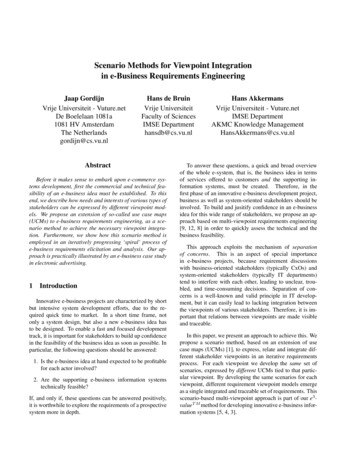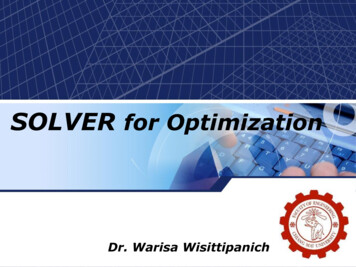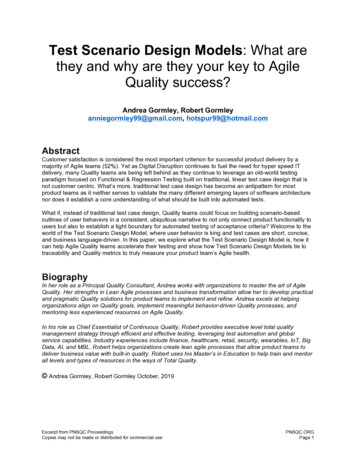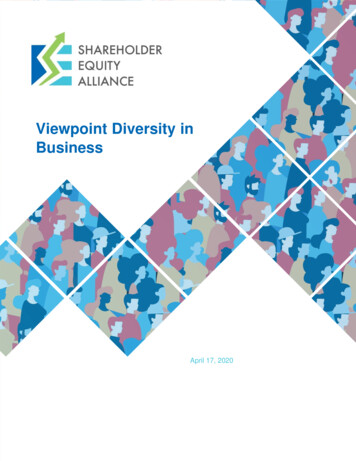
Transcription
Scenario Methods for Viewpoint Integrationin e-Business Requirements EngineeringJaap GordijnVrije Universiteit - Vuture.netDe Boelelaan 1081a1081 HV AmsterdamThe Netherlandsgordijn@cs.vu.nlHans de BruinVrije UniversiteitFaculty of SciencesIMSE Departmenthansdb@cs.vu.nlAbstractBefore it makes sense to embark upon e-commerce systems development, first the commercial and technical feasibility of an e-business idea must be established. To thisend, we describe how needs and interests of various types ofstakeholders can be expressed by different viewpoint models. We propose an extension of so-called use case maps(UCMs) to e-business requirements engineering, as a scenario method to achieve the necessary viewpoint integration. Furthermore, we show how this scenario method isemployed in an iteratively progressing ‘spiral’ process ofe-business requirements elicitation and analysis. Our approach is practically illustrated by an e-business case studyin electronic advertising.1IntroductionInnovative e-business projects are characterized by shortbut intensive system development efforts, due to the required quick time to market. In a short time frame, notonly a system design, but also a new e-business idea hasto be designed. To enable a fast and focused developmenttrack, it is important for stakeholders to build up confidencein the feasibility of the business idea as soon as possible. Inparticular, the following questions should be answered:1. Is the e-business idea at hand expected to be profitablefor each actor involved?2. Are the supporting e-business information systemstechnically feasible?If, and only if, these questions can be answered positively,it is worthwhile to explore the requirements of a prospectivesystem more in depth.Hans AkkermansVrije Universiteit - Vuture.netIMSE DepartmentAKMC Knowledge ManagementHansAkkermans@cs.vu.nlTo answer these questions, a quick and broad overviewof the whole e-system, that is, the business idea in termsof services offered to customers and the supporting information systems, must be created. Therefore, in thefirst phase of an innovative e-business development project,business as well as system-oriented stakeholders should beinvolved. To build and jusitify confidence in an e-businessidea for this wide range of stakeholders, we propose an approach based on multi-viewpoint requirements engineering[9, 12, 8] in order to quickly assess the technical and thebusiness feasibility.This approach exploits the mechanism of separationof concerns. This is an aspect of special importancein e-business projects, because requirement discussionswith business-oriented stakeholders (typically CxOs) andsystem-oriented stakeholders (typically IT departments)tend to interfere with each other, leading to unclear, troubled, and time-consuming decisions. Separation of concerns is a well-known and valid principle in IT development, but it can easily lead to lacking integration betweenthe viewpoints of various stakeholders. Therefore, it is important that relations between viewpoints are made visibleand traceable.In this paper, we present an approach to achieve this. Wepropose a scenario method, based on an extension of usecase maps (UCMs) [1], to express, relate and integrate different stakeholder viewpoints in an iterative requirementsprocess. For each viewpoint we develop the same set ofscenarios, expressed by different UCMs tied to that particular viewpoint. By developing the same scenarios for eachviewpoint, different requirement viewpoint models emergeas a single integrated and traceable set of requirements. Thisscenario-based multi-viewpoint approach is part of our e3 valueT M method for developing innovative e-business information systems [5, 4, 3].
2.2The motivation to develop scenarios is to build betterunderstanding of and confidence in the viability of an ebusiness idea. We do so by presenting ‘profit sheets’ and‘cost sheets’ for each actor that are derived from the mentioned scenarios. The major objective of these sheets is tojustify stakeholder confidence in the commercial and technical feasibility of a business idea, and not so much to obtain precise estimates of expected benefits. In fact, in theearly requirements stages of innovative e-business projects,the former is much more important (and realistic) than thelatter.This paper introduces in Sec. 2 our e3 -value framework,presents three important e-business viewpoints, and givesan outline of the UCM scenario method. In Sec. 3, wedescribe our approach and illustrate it by one of the practical e-business projects we have been carrying out. Sec. 4presents conclusions and lessons learnt.22.1Iterations in e-Business Requirements EngineeringA potential pitfall in innovative e-business projects isto follow a strict sequential ‘waterfall’ track of developingthe requirement viewpoints in detail. This may result in acomplete fine-grained business value model that howeveris impossible to realize in the given business process andsystem architecture environment. What is therefore neededinitially, is a coherent set of global requirements for an ebusiness system in which stakeholders have justifiable confidence that it is feasible to implement it, and that it has anunderlying business value model showing benefits to all actors involved. Only if stakeholders agree on such a set of requirements, it makes sense to further detail the requirementviewpoints so that implementation work can commence.For all the aforementioned viewpoints we develop (an extended version of) so-called use case maps based on thesame set of scenarios. If these scenarios are all supported bythe considered viewpoint, the business case is considered tobe technologically viable with respect to that viewpoint. Atthe same time, these scenarios are used to enhance our insight in the profitability for each actor, by drafting a profit orcost sheet per viewpoint for each actor. Such a first requirements engineering cycle should result in confidence that theinnovative e-business idea is technologically feasible, andthat the idea is commercially interesting for each actor inthe business value model.The e3 -value FrameworkViewpoints in Innovative e-Business Requirements EngineeringTo facilitate separation of concerns, we distinguish threerequirement viewpoints, which are based on importantgroups of stakeholders that participate in the requirementsengineering process. We only briefly discuss these viewpoints, as a more detailed report has appeared in [5].2.3Scenarios and Use Case MapsA UCM is a visual notation to be used by humans tounderstand the behavior of a system at a high level of abstraction [1]. It is a scenario-based approach intended toexplicate cause-effect relationships by travelling over pathsthrough a system.The basic UCM notation is very simple, and consistsof three basic elements: responsibilities, paths and components. The term component should be interpreted in a broadsense: it may be a software component, but it can also represent a human actor or a hardware system. A simple UCMexemplifying the basic elements is shown in Fig. 1. A pathis executed as a result of the receipt of an external stimulus.Imagine that an execution pointer is now placed on the startposition (bullet at the top). Next, the pointer moves alongthe indicated scenario path, thereby entering and leavingcomponents, and touching responsibility points. A responsibility point represents a place where the state of a systemis affected or interrogated. The effect of touching a responsibility point is not defined in the UCM itself since the concept of state is not part of a UCM; typically, this effect isdescribed in natural language. Finally, the end position isreached (stroke perpendicular to the scenario path) and theBusiness Value Viewpoint. The business value viewpointmodels a new, innovative way of doing business in terms ofvalues exchanged between actors. To represent this viewpoint, in previous work we have proposed a value-orientedmodelling technique, see [5, 4, 3] and Sec. 3.3.1.Business Process Viewpoint. The business process viewpoint shows the operational fullfillment of the businessvalue viewpoint by means of processes and workflows. Torepresent the business process viewpoint a number of existing techniques are suitable; in this paper we use Ould’srole-based process-modelling technique [10].System Architecture Viewpoint. The system architecture viewpoint shows how the requirements captured in thebusiness-value and business-process viewpoints can actually be realized in an information system. For our purposes,a system architecture will at this stage be primarily developed to assess both the technical and commercial feasibilityof a business idea. Once feasibility has been demonstratedfrom a business and system architecture viewpoint, the system architecture can be further elaborated.2
business idea the first iteration in exploring the aforementioned viewpoints to build confidence in commercial andtechnical feasibility. We construct one business value modeland a corresponding business process model. Subsequently,we discuss two software architectures that both realize thegiven business value and process model.3.2ScenariosThe first step after a statement of a business idea is tooutline the value-added services to be offered. This stepcan lead to multiple, alternative, sets of services. These services are explored with the help of scenarios, which we usethroughout the design of our viewpoints. A possible set ofscenarios for the business idea at hand is: A contact searcher submits an ad to a FAP, and gets apossible contact in return. The latter means that an adsubmission increases the chance for a contact searcherto find a contact s/he likes.Figure 1. UCM constructs.pointer is removed from the diagram.In the same Fig. 1, two frequently used UCM constructsare shown. The AND construct is used to spawn (ANDfork) and synchronize (AND-join) multiple activities alongparallel scenario paths. The OR construct is a means toexpress multiple independent scenario paths, which shareidentical sub-paths, within a single diagram.Furthermore, the UCM notation supports resources bymeans of pools. A scenario in progress can only removea resource from a pool if one or more resources are in it,otherwise the scenario will wait until a resource has beenstored into the pool by another scenario. A contact searcher queries for an ad on a website of aFAP, reads an ad, and pays a fee to the FAP. The Ad Association redistributes ads from FAPs toother FAPs, pays the originating FAP a fee, and getspaid by the FAPs who receive the ad.Many other sets of services are possible, for instance aset where FAPs exchange ads on a bilateral basis (withoutthe Ad Association). However, due to lack of space we onlyconside the former set of offerings.3.333.1Viewpoints and Scenarios Illustrated by ane-Business Case StudyBusiness Value ViewpointAfter an initial identification of scenarios, the next stepis to design the business value model. Besides reaching understanding between stakeholders on a first draft of the wayof doing business, a goal of developing the business valueviewpoint is to discover services, which could not be discovered by making a first set of scenarios.The Initial e-Business IdeaThe Ad Association is a company that co-ordinates morethan 150 local, world-wide located, free ad papers calledFAPs. FAPs independently produce (non-electronic) paperswith ads and serve a geographical region. The handling ofads is as follows. A customer submits an ad to a FAP. TheFAP checks the ad (e.g. for absence of dirty language andfor style) and places the ad in its next issue. It is possible toplace an international ad. In this case, the FAP to which thead was submitted distributes the ad to the Ad Association,which redistributes the ad to other FAPs (serving differentgeographical regions). These other papers publish the adas soon as possible. In a new e-business idea, the Ad Association and FAPs want to exploit their local establishedbrand names to develop an internationally, Internet based,contact ad service. The following sections show for this3.3.1Business Value Model ConstructsBelow, we briefly discuss the constructs which should bepresent in a business value model; an extensive discussionis given in [5, 6]. A general reference model for valueoriented e-business models is depicted in Fig. 2 and themain concepts that occur in it are summarized below.An actor is perceived by its environment as an independenteconomic (and often also legal) entity. By performing valueactivities (see below) actors add value, either for themselvesor for others. In a sound, viable, business model every actoris capable of adding value.3
new service, which is expected to be commercially viable:checking an ad. We mention in passing that this service wasnot present in the first set of scenarios. It was identified bystakeholders later in the project, because they were forcedto think about value adding activities.3.3.3Fig. 3 shows the UCM paths for each of the three scenariosidentified above, plus the checking scenario. A UCM pathis constructed by concatenating value offerings that causeeach other.Our value scenarios differ from the UCM method specified in [1]. The main difference is that Buhr supposes atime-ordering on a scenario path, while we only assumecausal relations. A business value model only states whatis exchanged for what; no time-ordering is assumed. Ourexperience is that time-ordering issues tend to give a wrongfocus in the discussion of the e-business model; stakeholders are primarily interested in who is doing what for whomand in the resulting revenues and costs. Because our scenario paths do not indicate time-ordering we have no scenario start- and endpoint as is normally the case in UCMs,but we have scenario delimiters instead.For the scenario submit ad, paths 1 and 2 model a submitted ad, which is accepted and published on one or morewebsite of FAPs, while paths 3 and 4 model a submitted adwhich is rejected. Note that a rejected ad does not resultin possible-contact nor ad-placement value offerings. Theonly offering that occurs is the check ad offering.On scenario paths, responsibility points are superimposed. We use these points to model changes in the profitsheet of an actor as a result of executing a scenario path.Changes in a profit sheet are caused by exchanges of valuesbetween actors via their value interfaces. Therefore, valueinterfaces are responsibility points by definition in a valuemodel. If we can estimate the number of times a scenariopath is executed, and we have all possible paths, we have abasic idea about the profitability of the business idea for aspecific actor.Figure 2. Value-based reference model for ebusiness models.A value activity is performed by an actor to produce objectsof value (outputs) by adding value to other objects of value(inputs).A value object is a service, thing, or consumer experiencethat is of value to one or more actors.A value port is a connector, which interconnects actors orvalue activities in a component-based way. Value ports offeror request value objects.A value interface is made up of one or more value ports,and models the offering of an actor or value activity to itsenvironment. It shows the value objects an actor is willingto exchange in return for other value objects via its ports. Itsworking is based on the principle “one good turn deservesanother”: a value object always has to be exchanged in return for another value object.A value exchange represents the trade of a value object between value ports. It shows which actors are willing to exchange objects of value with what other actors.A value offering consists of a set of value exchanges.Whereas value exchanges connect value ports, value offerings connect value interfaces of actors. The principle of“one good turn deserves another” is also valid for the valueoffering. For each value exchange, an ‘inverse’ value exchange should also be present, modelling the counterpart ofan offering by the connected actor.3.3.2Business Value Scenarios3.3.4ProfitabilityFor the scenario submit ad we derive a profit sheet for F APi(Table 1), which is constructed as follows.Business Value Model1. Make a list of values entering and leaving the actor.By following the scenario paths of a scenario, a list isconstructed consisting of all objects of value enteringor leaving the actor.Using the forementioned concepts, we present a businessvalue model (Fig. 3) for the business idea presented in Sec.3.1. For brevity, the model also shows the value scenarios(see Sec. 3.3.3). Note that in this viewpoint we only modelthe exchange of objects that are of value to someone and notobjects that result as I/O from a work activity (e.g. sending an invoice), which are modelled in the business processview. Also note that the business value model introduces a2. Remove the value-neutral in and out values. Somesets of value objects, which enter or leave an actor, andwhich are hard to quantify, are value-neutral for an actor. This means that after the execution of that path,4
Figure 3. Business value model with UCMs for the Ad Association business idea.the total value of objects in such a set is zero for anactor. This is for example the case if a value objectenters the actor and leaves the actor in the same scenario path. For example, consider the first scenariopath. The submitted ad, checked ad, possible contact,adto own publish activity , and adto Ad Associationare value-neutral for actor F APi because when thescenario has been executed, the actor has fulfilled itsobligations, that is ensuring that an ad is published,and this actor cannot use the ad anymore (e.g. resell itin another scenario path), because it has been alreadysold to all possible parties.in that scenario path.5. Estimate the likelihood of scenario paths. Based onestimations or previous experiences, the likelyhood ofoccurence for each scenario path of a specific scenariois specified.6. Calculate the expected profitability of a scenariopath. The expected value of each scenario path is calculated by multiplying the likelyhood of the occurenceof the path with the profitability of the path.7. Calculate the expected profitability of a scenario.Finally, we totalize the expected profitability of eachscenario path in the scenario.3. Estimate the value of the remaining value objects.The value of the remaining objects is expressed inmonetary units. For value objects representing amoney-based payment, this is trivial, but valuing otherobjects (such as the value of a possible contact for acontact searcher) is more complicated, and involvesdifferent qualities and value dimensions. In [7], a general approach is described for valuing such objects; in[4], we show an application of this approach to digitalcontent in a real-life e-business situation.If we fill-in the fees in Table 1, we get a first impressionof the profitability of the business-idea. Moreover, Table 1can be used to perform a sensitivity analysis of the profitability, for instance during a workshop with actors aboutthe value model. However, for a more overall view on theprofitability, additional cost sheets for the business processand information system requirements have to be developed.3.44. Calculate the profitability of scenario paths. Then,the profitability for each scenario path is calculated bytotalizing the values of all objects entering the actorand subtracting the values of objects leaving the actorBusiness Process ViewpointThe e-business process viewpoint illustrates processes tobe carried out by actors, and messages interchanged between those actors, on a conceptual level. Because we gain5
query asked by a contact searcher to a FAP, and the ad to bechecked, are new interactions, which are not represented inthe business value model.Table 1. Profit sheet for F APi for the scenariosubmit ad (Business Value viewpoint)ViewpointBusiness valueActorF APi3.4.2ScenarioSubmit adScenariopathProfit1 (60%)s1 f eedistrAdAssocation2 (20%)s2 f eedistrAdAssociationf eecheckF APother3 (15%)s3 04 (5%)s4 f eecheckF APotherExpectedprofitp 0.6 s1 0.2 s2 0.15 s3 0.05 s4In a business process model, an UCM scenario path showsthe time-sequence of messages and activities performed fora specific scenario. The same scenarios as in the businessvalue model are shown, however the paths now show a sequence of interactions between roles. Note the synchronization bar (with the N:1 indication) in the distribute ad,the place ad and the publish ad role. Such a bar ‘collects’a number of ads, say 100, and then continues the scenariowith one payment for all these 100 ads This refers to themechanism of aggregate payment [2]; it is much cheaper tohandle one big payment rather than a large number of smallones.Responsibility points indicate substantial operationalcosts, for instance caused by personnel. Selecting a capable checker, checking an ad, and administrating payments(received payments and payments done) are all tasks wherehumans are involved. These points are used to fill in thecost sheet for F APi (Table 2). Based on estimations ofthe occurence of the scenario paths, the expected costs forthe entire scenario is calculated, analogue to the process described in Sec. 3.3.4.Note that, although we use the same scenarios in all ourviewpoints, the scenario paths may differ in structure aswell as in number for each viewpoint. This is caused by thedifferent modelling perspectives of requirement viewpoints.In the business process viewpoint, scenario paths show similarities with paths for the business value model and are defined by concatenating interactions, which are numbered inFigure 4. more insight in how processes, necessary to create value,are carried out, it is possible to identify major operationalcosts such as costs caused by persons carrying out work.Responsibility points indicate such costs.3.4.1Business Process ModelA number of techniques have been developed to model business processes, such as UML activity diagrams with swimlanes to represent actors [11], or role-based process modelling techniques [10]. In this paper, we choose for the latter. Ould defines a role as a set of activities that are carriedout by an actor in an organization. An activity is what actorsdo in their roles. Between activities and thus between rolesinteractions can occur.Fig. 4 shows a process model which explains how thebusiness value model is carried out by actors. We do notshow the interactions explicitly to prevent unneccessarycluttering of the diagram. Interactions are implicitly shownby the UCMs.There are no strict rules to map the business value modelonto a process model because they express different viewpoints. There are, however, informal guidelines to derive aprocess model from an business value model. Value activities are mapped onto roles. Value exchanges are candidatesfor interactions between roles. However, value exchangesare not the same as interactions. Value exchanges denotethings of value to (other) actors which do not always result in interactions between actors directly. Also, new interactions may be introduced that do not have a counterpart in value exchanges. For example, value exchanges regarding payments between value activities performed by thesame FAP need not have a counterpart in interactions. TheBusiness Process ScenariosTable 2. Cost sheet for F APi for the scenariosubmit ad (Business Process viewpoint)ViewpointBusiness processActorF APiScenarioSubmit adScenarioCostspath1 (60%)c1 select-costs check-costs admin-costs/N2 (20%)c2 select-costs (2 admin-costs)/N3 (15%)c3 select-costs check-costs4 (5%)c4 select-costs admin-costs/NExpectedcbusiness process 0.6 c1 0.2 c2 costs0.15 c3 0.05 c46
Figure 4. Business process model for the Ad Association business idea.3.53.5.1System Architecture Viewpoint3.5.2System Architecture ScenariosWe will now evaluate the two achitectural solutions withrespect to the variation centralized versus decentralizeddatabase. We neglect network costs, because the currenttendency is that these are much cheaper then database ormessage server costs. The database server costs compriseall costs for having a local or central database server. For thedecentralised scenario, we assume a message server (e.g.,an SMTP server), which incurs costs. All these costs areaccounted for on a per scenario basis. This means that nofixed costs exists, as these are allocated to each individualexecution of a scenario, based on the expected number ofexecutions per time-frame. Note that the database server(s)and the message server are not part of the business valueand process model, so their impact on the costs cannot beassessed by evaluating a business value or process model inisolation.Table 3 and Table 4 show costs for the scenario submit adfor all actors (except contact searchers). For the submit adscenario, 4 paths can be identified (paths 1,2 for ads whichare published and locally or remotely checked, paths 3,4 forads which are rejected and locally or remotely checked).System ArchitectureTwo candidate system architectures will be presented forthe Ad Association case. Both are based on a 3-tier architectural style in which a system is decomposed into threecomponents: (1) the database, (2) the business logic, and(3) the user interface. This division reflects the principle ofseparation of concerns: a component should be responsiblefor one task only. Adhering to this principle minimizes theimpact of change of one component on other ones. In addition, a 3-tier architectural style caters for distributednessand scalability. All of these are important quality attributesin e-business systems.The following two architectural variations have been designed: (1) a decentralized database (Fig. 5) and (2) a centralized database (Fig. 6). In the first alternative, each FAPmaintains its own database of ads that are offered to itsreaders, and sends its ads to the Ad Association for furtherdistribution. In the second alternative, the Ad Associationmaintains the database of all ads for all readers centrally. Areader sends a request for an ad via the website of a localFAP, but this FAP will forward the request to the Ad Association.3.6Profitability and FeasibilityWe have performed the first cycle of our proposed requirements engineering process for innovative e-business7
Figure 5. A decentralized architecture.Figure 6. A centralized architecture.8
Table 3. Cost sheet for the decentralized variant (System Architecture viewpoint)Viewpoint System architecture (decentralized)ActorF APiF APother Ad AssociationScenario Submit ad (Costs)1 (60%) decentr00dbase2 (20%) decentr00dbase3 (15%) 0004 (5%)000Scenario Distribute ad (Costs)10decentrmessage(100%)dbaseserverScenario Read ad (Costs)10decentr0(100%)dbaseTable 4. Cost sheet for the centralized variant(System Architecture viewpoint)Viewpoint System architecture (centralized)ActorF APiF APother Ad AssociationScenario Submit ad (Costs)1 (60%) 00centraldbase2 (20%) 00centraldbase3 (15%) 0004 (5%)000Scenario Distribute ad (Costs)1000(100%)Scenario Read ad (Costs)100central(100%)dbaseviewpoints. For example, for the centralized variant, database costs for FAPs are likely to be lowerthan in the decentralized variant, but the redistribution fee may be higher due to a database, whichhas to be exploited by the Ad Association.information systems to be able to answer the questionswhether the business idea at hand is profitable and feasible.A first positive idea about the technical feasilibility hasbeen given by outlining a business process model andtwo system architectures for the service-based scenario set,which support all the identified scenarios.Confidence building in commercial viabilibility is muchmore complicated. This process is performed as follows.(b) Calculate expected profit/costs per scenario occurrence. For each scenario, an actor is involvedin, totalize the profits found for each viewpointin the previous step.1. Estimate scenario frequency. For each scenario, estimate the number of times a scenario occurs in a givenperiod (say a month).(c) Calculate total expected profit for an actor. Calculate the total profit for an actor, by, for eachscenario, multiplying the number of times a scenario occurs with the profit of a scenario occurence, and by totalizing all these products forscenarios performed by the actor.2. Identify requirement sets. Requirement sets areformed by all meaningful combinations of system architectures, which support the corresponding businessprocesses and business value models. In this paper, wehave two sets: (1) the set comprised by the businessvalue model, the process model, and the centralizedsystem architecture, and (2) the set consisting of thesame business value and process models, and the decentralized system architecture.Note that we must aggregate profits/costs of each viewpoint on the scenario level and not on the scenario pathlevel. Scenarios are conceptually the same for each viewpoint, but it is possible that viewpoints contain differentnumbers of scenario paths for the same conceptual scenario.3. Estimate overall profit of a requirement set for eachactor.4(a) Estimate profit/costs per viewpoint per scenariooccurrence. Estimate, per scenario and per viewpoint , the profit/costs of an actor. This process is explained in Secs. 3.3.4, 3.4.2, and 3.5.2.The overall estimate should take in account theinsight in the scenario’s profit and cost factors,which is obtained from all three requirementConclusions and Lessons LearnedThe key point of this paper is that in a first stage ofrequirements engineering for innovative e-business ideas,quick justification is needed concerning the commercial viability of the initial idea as well as its technical feasibility,before starting an in-depth requirement engineerings track.To this end, we have proposed a scenario method thatexploits separation of concerns to
Business Process Viewpoint. The business process view-point shows the operational fullfillment of the business value viewpoint by means of processes and workflows. To represent the business process viewpoint a number of ex-isting techniques are suitable; in this paper we use Ould's role-based process-modelling technique [10].










